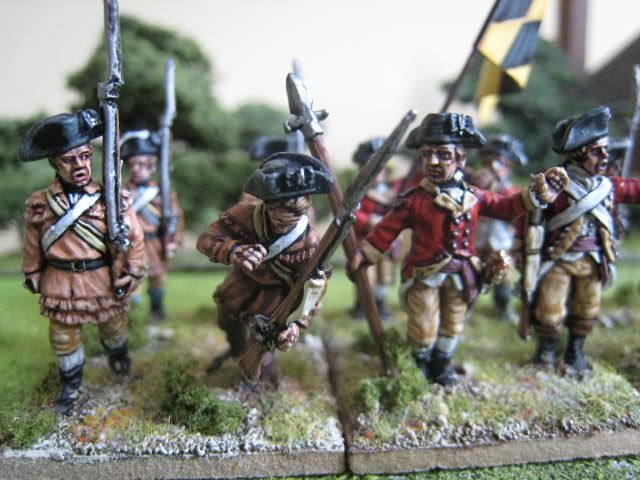

Another more unusual unit that I had to prepare for the Long Island game was the 4th combined grenadier battalion. This was comprised of highlanders from the 42nd Foot and the 71st Foot. Given the 3 battalions of the latter regiment, the strength of the regiment was some 320 men in 4 companies. Although brigaded historically with the other grenadier battalions, in the Long Island game this unit was detached and added to the main British attack (I forget in which brigade). It was the Perry charging highlander figures that first tweaked my interest in this period; I think the faces have some of the finest expressions that Alan Perry has made. Whilst I know some readers will wince at the full plaid (hi Bob!), you can't deny that a full battalion of charging jocks in highland dress is a stirring sight.
I originally painted a 6-figure base of 42nd grenadiers in 2004 and then added a couple more 4-figure bases a year or so later, another 42nd and one for the 71st. For this unit I rebased them all and generally smartened them up a bit. Noting that I had too many Black Watch and insufficient Fraser's, I repainted the facings of 4 figures to bring them within the 71st. I then had to paint a further 2 figures from scratch. As a result, one base contains the earliest Brits I ever painted for the AWI from 4 years ago and the most recent from October (see the close-ups below)! The difference in painting style is most apparent in the faces - back in 2004 I was using the "black eyeliner" method for painting eyes. I changed from that a year later, as it seemed to me that all my figures looked as if they'd just had a make-up trial at Selfridges. Since then I paint eyes by painting the whole face in the flesh base colour, adding a dark brown wash to pick out the eye sockets, painting white eyeballs and finally adding black pupils and, if appropriate, top eyelids; I think this looks a bit more natural that painting the eyes in black and then adding white etc. Half the figures have a black stripe in their tartan and the others have red - this is an attempt to divide the figures into the first and second battalions of their respective regiments. I have no idea if this is in any way correct - some references I have seen to AWI/government sett tartan state that grenadiers had a red stripe whilst others say they had black.
These chaps did well at the Long Island game, making it into the Brooklyn lines before being thrown out shortly thereafter. For the "British Grenadier!" later Monmouth scenario, which requires two grenadier units of a staggering 32-figures each, this unit will be combined with the 16-figure 3rd Grenadiers. My "1st Grenadiers" is only 24 figures strong (see here), so at some stage I will need to add 8 more figures to it. As I've noted before, you don't need so many grenadiers for most AWI scenarios; one unit of 20-24 figures will suffice for most engagements. Still, you can't quite beat a full battalion of highlanders in full plaid....
16 figures. Painted various times from 2004-October 2008.










